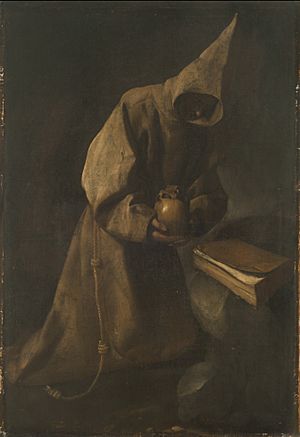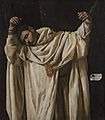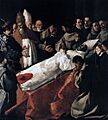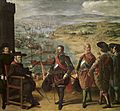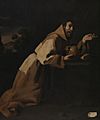Francisco de Zurbarán facts for kids
Quick facts for kids
Francisco de Zurbarán
|
|
|---|---|

Probable self-portrait of Francisco de Zurbarán as Saint Luke, c. 1635–1640
|
|
| Born |
Francisco de Zurbarán
baptized 7 November 1598 |
| Died | 27 August 1664 (aged 65) Madrid, Spain
|
| Nationality | Spanish |
| Known for | painting |
| Movement | Baroque Caravaggisti |
| Patron(s) | Philip IV of Spain Diego Velázquez |
Francisco de Zurbarán (baptized 7 November 1598 – 27 August 1664) was a famous Spanish painter. He is best known for his religious paintings. These often showed monks, nuns, and important religious figures. He also painted amazing still-life pictures.
Zurbarán was nicknamed "Spanish Caravaggio". This was because he was very good at using a painting style called chiaroscuro. This style uses strong contrasts between light and dark to create a dramatic effect.
He was also the father of another painter, Juan de Zurbarán.
Biography
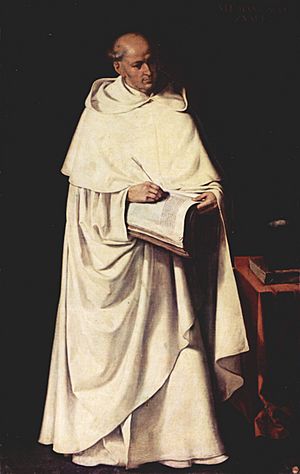
Francisco de Zurbarán was born in 1598 in Fuente de Cantos, a town in Extremadura, Spain. He was baptized on November 7 of that year. His father, Luis de Zurbarán, sold small items like needles and thread. His mother was Isabel Márquez. Even as a child, Francisco loved to draw objects using charcoal.
In 1614, when he was about 16, his father sent him to Seville. There, he became an apprentice for three years to a painter named Pedro Díaz de Villanueva. Not much is known about this teacher.
Zurbarán got married for the first time in 1617 to María Paet. She was nine years older than him. Sadly, María passed away in 1624 after they had their third child. In 1625, he married again to a wealthy widow named Beatriz de Morales.
In 1626, Zurbarán signed an important agreement. He promised to create 21 paintings for a monastery in Seville within eight months. These paintings included scenes from the life of Saint Dominic and other important saints. This big project helped Zurbarán become a well-known painter.
His fame grew, and in 1629, the leaders of Seville asked him to move there permanently. They believed his art would make the city even more famous. He accepted and moved to Seville with his family and servants. His second wife, Beatriz de Morales, died in May 1639.
Around 1630, King Philip IV made Zurbarán his official painter. There's a story that the King once put his hand on Zurbarán's shoulder and said, "Painter to the king, king of painters."
After 1640, Zurbarán's style, which was very serious and clear, became less popular. People started to prefer the more emotional religious paintings of Murillo.
Zurbarán's workshop also started making many paintings to sell in South America. A famous series of paintings called Jacob and his twelve sons was likely made for this market. However, these paintings ended up in Auckland Castle in England.
On February 7, 1644, Zurbarán married for a third time to another wealthy widow, Leonor de Torder. In 1658, late in his life, he moved to Madrid. He hoped to find more work there and reconnected with his friend, the famous painter Diego Velázquez. Some people thought Zurbarán died poor, but he actually had a good amount of money when he passed away in 1664.
Artistic Style
It's not known if Zurbarán ever saw paintings by Caravaggio. However, Zurbarán's work also uses strong contrasts of light and shadow, a technique called tenebrism. Art experts believe that the painter Juan Sánchez Cotán greatly influenced Zurbarán's serious and simple compositions.
Zurbarán was also inspired by polychrome sculpture. This type of sculpture, popular in Seville, used many colors. The sculptures of Juan Martínez Montañés were especially similar to Zurbarán's paintings in their feeling.
Zurbarán painted his figures by looking at real people. He also used a special kind of doll, called a lay-figure, to help him study how clothes would drape. He was especially good at painting white fabrics. Because of this, many of his paintings feature the white robes of Carthusians (a type of monk).
Zurbarán's paintings often show serious religious moments. They focus on the idea of the spirit controlling the body. His compositions often feature just one figure. His style is more calm and controlled than Caravaggio's, and his colors often have a bluish tone. He created amazing effects by painting the front parts of his pictures very carefully, using strong light and shadow. The backgrounds in his paintings are often plain and dark. Zurbarán sometimes had trouble painting deep spaces. When he did show indoor or outdoor scenes, they often looked like theater backdrops on a shallow stage.
Zurbarán's later works, like his Saint Francis (around 1658–1664), show the influence of other painters like Murillo and Titian. These later paintings have softer colors and brushstrokes.
Famous Works
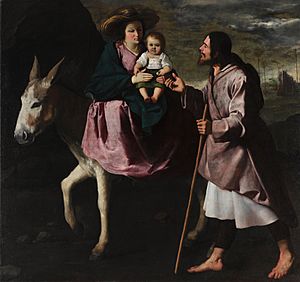
In 1631, Zurbarán painted a very large altarpiece called The Apotheosis of Saint Thomas Aquinas. An altarpiece is a work of art placed behind the altar in a church. This painting is now in the Museum of Fine Arts of Seville. It is Zurbarán's biggest painting, showing many figures, including Christ, the Madonna, saints, and important historical figures.
Between 1628 and 1634, he painted four scenes about the life of St. Peter Nolasco for a monastery in Seville. He also created many large paintings for the church in Santa Maria de Guadalupe. Eight of these paintings showed the life of St. Jerome. In another church in Seville, he painted a figure of the Crucified Saviour using a technique called grisaille. This technique uses only shades of gray to make the painting look like marble.
In 1639, he finished the paintings for the main altar of the Carthusian monastery in Jerez de la Frontera. In the 1630s, he was also asked to paint scenes from the Labours of Hercules. These were the only mythological paintings Zurbarán ever made. They were placed in the Hall of Realms in Madrid. A great example of his work is in the National Gallery, London: a life-sized painting of Saint Francis kneeling and holding a skull.
In 1835, many of Zurbarán's paintings were taken from monasteries and put on display in the new Museum of Cádiz.
Some of his most important students were Bernabé de Ayala, Juan Caro de Tavira, and the Polanco brothers.
Zurbarán's art has been featured in major exhibitions. In 1987, there was a big show at the Metropolitan Museum of Art in New York. In 2015, the Thyssen-Bornemisza Museum in Madrid presented "Zurbarán. A New Perspective."
Selected works
- Christ on the Cross (1627), Art Institute of Chicago
- Hercules and the Hydra
- St Hugh in the Carthusian Refectory (1630–1635), Museum of Fine Arts of Seville
- Still Life with Pots (1650), Museo del Prado (autographed version)
Images for kids
-
Santo Domingo en Soriano, 1626, Santa María Magdalena, Seville
-
Saint Serapion, 1628, Wadsworth Atheneum
-
The Death of St. Bonaventure (The Body of St. Bonaventure in the Presence of Pope Gregory X and James I of Aragon), 1629–1630, Louvre Museum
-
The Young Virgin, 1630, Metropolitan Museum of Art
-
The Defence of Cádiz against the English, 1634, Museo del Prado
-
A Doctor of Law, 1635, Isabella Stewart Gardner Museum
-
Santa Isabel de Portugal, c. 1635, Museo del Prado
-
Saint Luke as a Painter before Christ on the Cross, c. 1635–1640, Museo del Prado
-
Saint Rufina, c. 1635–1640, National Gallery of Ireland
-
Saint Francis of Assisi in His Tomb, 1630/34, Milwaukee Art Museum
-
Saint Francis, c. 1658–1664, Alte Pinakothek
-
Agnus Dei, c. 1635–1640, Museo del Prado
See also
 In Spanish: Francisco de Zurbarán para niños
In Spanish: Francisco de Zurbarán para niños


